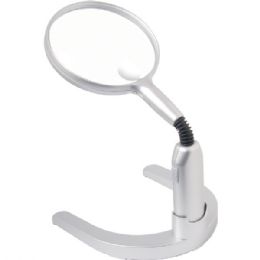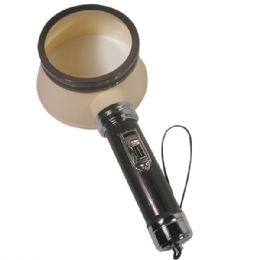





.jpg&newheight=260&quality=80)







.jpg&newheight=260&quality=80)
.jpg&newheight=260&quality=80)


.jpg&newheight=260&quality=80)
Magnifiers are an important element in many daily activities. Whether its application is for personal, professional or commercial use, a magnifier enhances the ability to enjoy a hobby or perform a task. Understanding how magnification works and how to get the most out of a magnifier improves its utilization.
What do Magnification Terms Mean?
The distance from the center of the lens to the viewed object is called the focal length. When the focal length decreases, magnification increases. A term used to identify the refractive (light bending) capacity of a lens is called the diopter (d). In a magnifier, there is a direct correlation between the diopter and the focal length. To find the diopter of a lens, start with the eyes 10 inches above the lens. Then, move the object to be viewed to a point where it remains in sharp focus and is farthest away from the lens. Measure this distance and divide it into 39.37 inches (1 meter). The answer is the diopter of the lens. For example, if the object is 13 inches from the lens, than it has a 3-diopter lens (39.37/13 = 3d).
When the object is at its full focal length from the lens, each diopter increases the size of the object viewed by 25%. A magnifier’s field of view is the distance across the lens surface when the viewer has both eyes 10 inches above the lens. As magnification increases, the field of view and focal length decrease. Magnification is the degree to which the viewed object is enlarged and is normally expressed by a number followed by an “X”. This expresses the power, or the enlarged size of the object in relation to its actual size.
What is an Illuminated Magnifier?
An illuminated magnifier is a compact, high quality magnification device which can be handheld or hands free. It operates on batteries to make it portable and easy to use at home or when traveling. A magnifier is easily stored in a pocket or drawer and takes up minimal space. It assists those with low vision or those who need extra help examining objects, documents, puzzles, and reading books and newspapers by enlarging the object. It also provides an extra source of light for a dimly lit setting.
Some have a large, raised switch so fingers with arthritis can manage the device easier. Other magnifiers have an interchangeable head to allow personalization, to update it, if the lens is lost or broken, or if a person’s vision requires a stronger lens in the future. Another type of magnifier is activated by picking it up and holding it in either hand, while it automatically turns off when it is released. This type may also include rechargeable batteries, which eliminates the need for constant battery changes. An LED light source is an option some magnifiers offer, while a xenon bulb is used in others.
A magnifier lamp can be utilized as a handheld device or on its stand. It has a flexible neck to assist in customizing the view along with a small magnification spot for closer viewing. A lamp is ideal for desk or counter top areas since it does not take up much space and stays within reach. Being battery powered, it can be moved from one location to another. Interchangeable heads are available in many sizes in case one is lost or broken, or if a stronger one is required. Illuminated magnifiers come in various diopter and magnification strengths to fit individual needs.
Rehabmart is pleased to offer a comprehensive selection of innovative illuminated magnifiers from high quality vendors that include MaxiAids, LSS, and Maddak.
Hulet Smith, OT
Rehabmart Co-Founder & CEO
lb